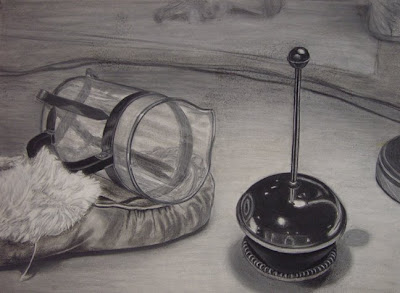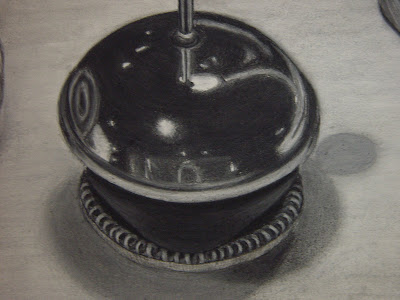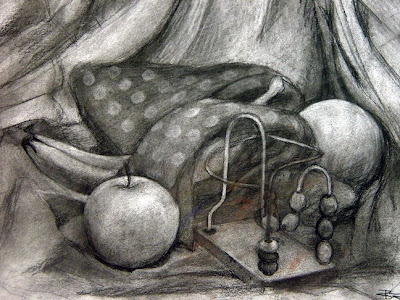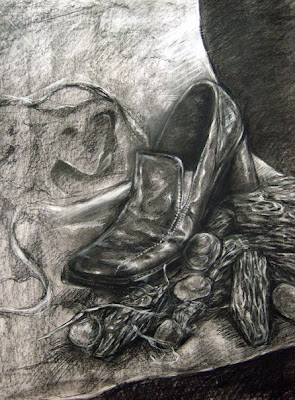Materials Required:
-Options: charcoal pencils and white chalk or black & white conte sticks or black & white
-Clip-on light
Objects must be Thematic (10 % of Assignment):
Consider potential layers of thematic content in selective objects such as personal narratives, cultural references and expressive characteristics in objects and the way objects have been set up. Overall to have successful thematic content consider the selected object, composition, view point of object and lighting - these will all have potential in developing thematic content in drawing.
Select your objects now! Do not wait last limit to select objects.
Formal Characteristics of Drawing (80 % of Assignment):
-Strategic Use of Detail: Consider progression of space in relation to various levels of detail, contrast and edges
-Strategic Use of Contrast: Maximum detailing and high contrast in foreground progressing to decreased detail and low contrast into the background space
-Strategic Variation of Edges: Sharp (in focus) edges in foreground progressing to softer (out of focus) edges in background (Variation of mark making plays a part in this) Absorb all lines into shaded areas!
- Progressions of Space: Have progression not only in a broad sense, but also at each level of foreground, middle ground, background. For example, on a round or cylindrical object, the center will be higher in detail and contrast because it is closer to the viewer.
-Surface Plane & Composition: Depict the plane or surface the objects are set up on and consider the atmosphere around the objects in the entire composition.
-Variation of Objects: In addition to being thematically layered, select objects that are visually interesting or at least set up objects in an interesting way. Once again consider the visual movements created by objects in composition.
Process (Steps to Assist in Addressing Formal Characteristics):
-Highlights can be made with eraser or white drawing material such as white conte, or white chalk pencils or potentially white oil pastel!
Unifying Formal and Thematic Content (10 % of Assignment):
Consider how thematic content is reinforced by formal decisions such as composition, view point of object and lighting. As well, the way the object is depicted in terms of mark making and the observational drawing style can also have potential thematic content in the drawing.
 The
above example presents a very good depiction of reflective and
transparent objects. As well the objects are given a context that
suggest thematic content with the anticipation of the knife cutting into
the vegetable. This work at a basic level begins to convey possible
symbolic or metaphorical content.
The
above example presents a very good depiction of reflective and
transparent objects. As well the objects are given a context that
suggest thematic content with the anticipation of the knife cutting into
the vegetable. This work at a basic level begins to convey possible
symbolic or metaphorical content.Grayscale:
 The
above is an example of a 16 step digital grayscale. All rendered black
and white drawings are required to utilize the grayscale for each black
and white material used in the course.
The
above is an example of a 16 step digital grayscale. All rendered black
and white drawings are required to utilize the grayscale for each black
and white material used in the course.The grayscale in a drawing is achieved by layering a black medium and allowing different levels of the white of the paper to come through in a drawing, OR a grayscale is achieved by mixing black and white mediums to achieve the range presented in the above grayscale. Often drawings use a combination of both methods (utilizing the white of the paper AND mixing the white with black drawing mediums together)
Creating your own grayscale for each drawing medium will assist in learning about each drawing materials characteristics, plus will allow you to practice depicting and to be more sensitized to the full range of grays in a drawing. Once each grayscale is completed it can be used to compare grayscale levels in a drawing ultimately assisting in the overall success of any given drawing.
Value, Tints and Shades:

The drawings above demonstrates a depiction of value. Colour has been translated into grayscale. During most of the rendering assignments the objective will be to ignore translating colour and instead will focus on light and shadow and at times will depict surface qualities of texture, reflection and transparency.

 detail
detail detail
detail The drawing above demonstrates a depiction of value. Colour has been translated into grayscale.
The drawing above demonstrates a depiction of value. Colour has been translated into grayscale.
See Links Below of Additional Examples for Some Formal Ideas:
http://derekbruecknercourseinformation.blogspot.com/2009/10/rendered-shaded-drawing-objectives.html
http://derekbruecknercourseinformation.blogspot.com/2008/04/blog-post_12.html







No comments:
Post a Comment